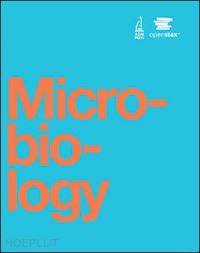
Questo prodotto usufruisce delle SPEDIZIONI GRATIS
selezionando l'opzione Corriere Veloce in fase di ordine.
Pagabile anche con Carta della cultura giovani e del merito, 18App Bonus Cultura e Carta del Docente
Microbiology covers the scope and sequence requirements for a singlesemester microbiology course for nonmajors.
The book presents the core concepts of microbiology with a focus on applications for careers in allied health. The pedagogical features of the text make the material interesting and accessible while maintaining the careerapplication focus and scientific rigor inherent in the subject matter. Microbiology’s art program enhances students’ understanding of concepts through clear and effective illustrations, diagrams, and photographs.
Preface
1. An Invisible World
Introduction
1.1. What Our Ancestors Knew
1.2. A Systematic Approach
1.3. Types of Microorganisms
2. How We See the Invisible World
Introduction
2.1. The Properties of Light
2.2. Peering Into the Invisible World
2.3. Instruments of Microscopy
2.4. Staining Microscopic Specimens
3. The Cell
Introduction
3.1. Spontaneous Generation
3.2. Foundations of Modern Cell Theory
3.3. Unique Characteristics of Prokaryotic Cells
3.4. Unique Characteristics of Eukaryotic Cells
4. Prokaryotic Diversity
Introduction
4.1. Prokaryote Habitats, Relationships, and Microbiomes
4.2. Proteobacteria
4.3. Nonproteobacteria GramNegative Bacteria and Phototrophic Bacteria
4.4. GramPositive Bacteria
4.5. Deeply Branching Bacteria
4.6. Archaea
5. The Eukaryotes of Microbiology
Introduction
5.1. Unicellular Eukaryotic Parasites
5.2. Parasitic Helminths
5.3. Fungi
5.4. Algae
5.5. Lichens
6. Acellular Pathogens
Introduction
6.1. Viruses
6.2. The Viral Life Cycle
6.3. Isolation, Culture, and Identification of Viruses
6.4. Viroids, Virusoids, and Prions
7. Microbial Biochemistry
Introduction
7.1. Organic Molecules
7.2. Carbohydrates
7.3. Lipids
7.4. Proteins
7.5. Using Biochemistry to Identify Microorganisms
8. Microbial Metabolism
Introduction
8.1. Energy, Matter, and Enzymes
8.2. Catabolism of Carbohydrates
8.3. Cellular Respiration
8.4. Fermentation
8.5. Catabolism of Lipids and Proteins
8.6. Photosynthesis
8.7. Biogeochemical Cycles
9. Microbial Growth
Introduction
9.1. How Microbes Grow
9.2. Oxygen Requirements for Microbial Growth
9.3. The Effects of pH on Microbial Growth
9.4. Temperature and Microbial Growth
9.5. Other Environmental Conditions that Affect Growth
9.6. Media Used for Bacterial Growth
10. Biochemistry of the Genome
Introduction
10.1. Using Microbiology to Discover the Secrets of Life
10.2. Structure and Function of DNA
10.3. Structure and Function of RNA
10.4. Structure and Function of Cellular Genomes
11. Mechanisms of Microbial Genetics
Introduction
11.1. The Functions of Genetic Material
11.2. DNA Replication
11.3. RNA Transcription
11.4. Protein Synthesis (Translation)
11.5. Mutations
11.6. How Asexual Prokaryotes Achieve Genetic Diversity
11.7. Gene Regulation: Operon Theory
12. Modern Applications of Microbial Genetics
Introduction
12.1. Microbes and the Tools of Genetic Engineering
12.2. Visualizing and Characterizing DNA, RNA, and Protein
12.3. Whole Genome Methods and Pharmaceutical Applications of Genetic Engineering
12.4. Gene Therapy
13. Control of Microbial Growth
Introduction
13.1. Controlling Microbial Growth
13.2. Using Physical Methods to Control Microorganisms
13.3. Using Chemicals to Control Microorganisms
13.4. Testing the Effectiveness of Antiseptics and Disinfectants
14. Antimicrobial Drugs
Introduction
14.1. History of Chemotherapy and Antimicrobial Discovery
14.2. Fundamentals of Antimicrobial Chemotherapy
14.3. Mechanisms of Antibacterial Drugs
14.4. Mechanisms of Other Antimicrobial Drugs
14.5. Drug Resistance
14.6. Testing the Effectiveness of Antimicrobials
14.7. Current Strategies for Antimicrobial Discovery
15. Microbial Mechanisms of Pathogenicity
Introduction
15.1. Characteristics of Infectious Disease
15.2. How Pathogens Cause Disease
15.3. Virulence Factors of Bacterial and Viral Pathogens
15.4. Virulence Factors of Eukaryotic Pathogens
16. Disease and Epidemiology
Introduction
16.1. The Language of Epidemiologists
16.2. Tracking Infectious Diseases
16.3. Modes of Disease Transmission
16.4. Global Public Health
17. Innate Nonspecific Host Defenses
Introduction
17.1. Physical Defenses
17.2. Chemical Defenses
17.3. Cellular Defenses
17.4. Pathogen Recognition and Phagocytosis
17.5. Inflammation and Fever
18. Adaptive Specific Host Defenses
Introduction
18.1. Overview of Specific Adaptive Immunity
18.2. Major Histocompatibility Complexes and AntigenPresenting Cells
18.3. T Lymphocytes and Cellular Immunity
18.4. B Lymphocytes and Humoral Immunity
18.5. Vaccines
19. Diseases of the Immune System
Introduction
19.1. Hypersensitivities
19.2. Autoimmune Disorders
19.3. Organ Transplantation and Rejection
19.4. Immunodeficiency
19.5. Cancer Immunobiology and Immunotherapy
20. Laboratory Analysis of the Immune Response
Introduction
20.1. Polyclonal and Monoclonal Antibody Production
20.2. Detecting AntigenAntibody Complexes
20.3. Agglutination Assays
20.4. EIAs and ELISAs
20.5. Fluorescent Antibody Techniques
21. Skin and Eye Infections
Introduction
21.1. Anatomy and Normal Microbiota of the Skin and Eyes
21.2. Bacterial Infections of the Skin and Eyes
21.3. Viral Infections of the Skin and Eyes
21.4. Mycoses of the Skin
21.5. Protozoan and Helminthic Infections of the Skin and Eyes
22. Respiratory System Infections
Introduction
22.1. Anatomy and Normal Microbiota of the Respiratory Tract
22.2. Bacterial Infections of the Respiratory Tract
22.3. Viral Infections of the Respiratory Tract
22.4. Respiratory Mycoses
23. Urogenital System Infections
Introduction
23.1. Anatomy and Normal Microbiota of the Urogenital Tract
23.2. Bacterial Infections of the Urinary System
23.3. Bacterial Infections of the Reproductive System
23.4. Viral Infections of the Reproductive System
23.5. Fungal Infections of the Reproductive System
23.6. Protozoan Infections of the Urogenital System
24. Digestive System Infections
Introduction
24.1. Anatomy and Normal Microbiota of the Digestive System
24.2. Microbial Diseases of the Mouth and Oral Cavity
24.3. Bacterial Infections of the Gastrointestinal Tract
24.4. Viral Infections of the Gastrointestinal Tract
24.5. Protozoan Infections of the Gastrointestinal Tract
24.6. Helminthic Infections of the Gastrointestinal Tract
25. Circulatory and Lymphatic System Infections
Introduction
25.1. Anatomy of the Circulatory and Lymphatic Systems
25.2. Bacterial Infections of the Circulatory and Lymphatic Systems
25.3. Viral Infections of the Circulatory and Lymphatic Systems
25.4. Parasitic Infections of the Circulatory and Lymphatic Systems
26. Nervous System Infecti











Il sito utilizza cookie ed altri strumenti di tracciamento che raccolgono informazioni dal dispositivo dell’utente. Oltre ai cookie tecnici ed analitici aggregati, strettamente necessari per il funzionamento di questo sito web, previo consenso dell’utente possono essere installati cookie di profilazione e marketing e cookie dei social media. Cliccando su “Accetto tutti i cookie” saranno attivate tutte le categorie di cookie. Per accettare solo deterninate categorie di cookie, cliccare invece su “Impostazioni cookie”. Chiudendo il banner o continuando a navigare saranno installati solo cookie tecnici. Per maggiori dettagli, consultare la Cookie Policy.